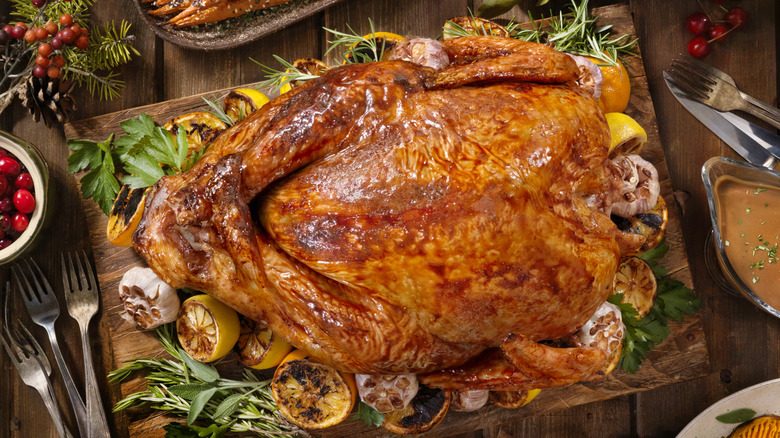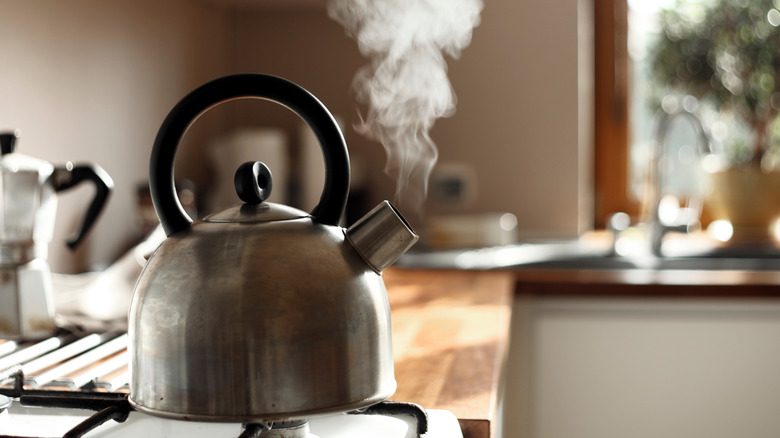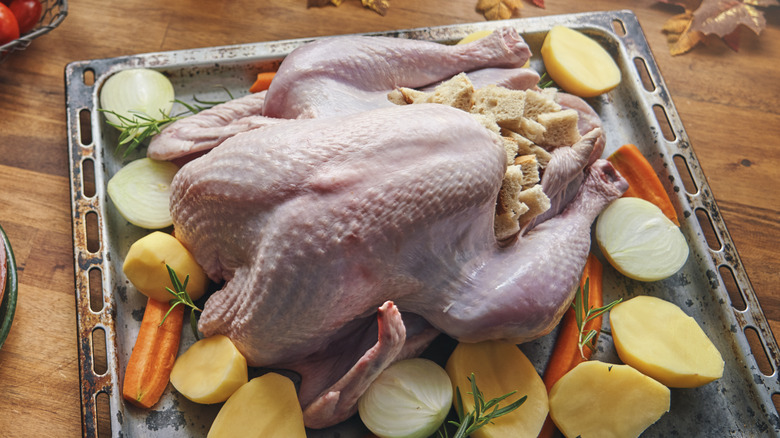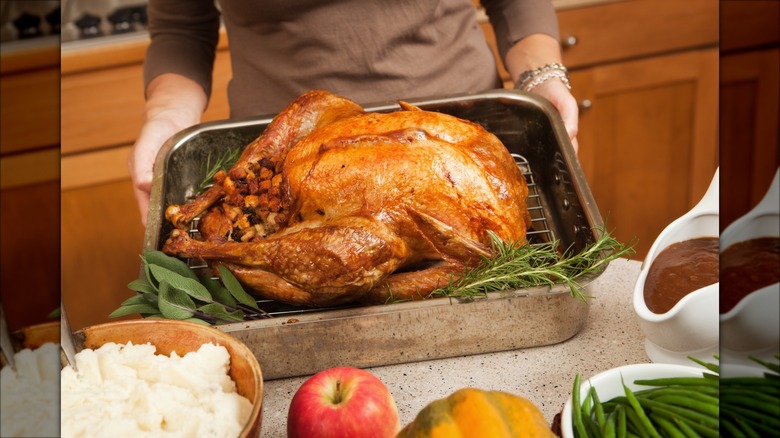Pouring Boiling Water Over A Whole Turkey Is A Holiday Game Changer
The close of the year brings many joyous and indulgent celebrations, the fellowship of friends and family, and the wondrous cornucopia of holiday banquets resplendent with food and drink. Alas, for the uninitiated, the season also entails the nightmare of attempting to properly cook a whole turkey. In addition to dry breast meat, greasy, limp outer skin is something to be avoided at all costs. Alongside our tips for roasting the perfect turkey, we'd like to offer one more technique that will meaningfully address the turkey-skin challenge: Pour boiling water over that sucker to set yourself up for crispy skin goodness.
We've already explored using boiling water showers on whole chickens and, at least in this respect, turkeys are a distinction without a difference. The basic goal is to cause the skin to shrink and contract so as to do away with the overabundance of moisture on its surface and the fat beneath it— as both are impediments to crispiness. The heat of the boiling water neatly accomplishes all these objectives, removing the element of chance from the cooking process and guaranteeing a mouthwatering (and retaining) result.
The science of crispy turkey skin
Moisture, though necessary for succulent bites, is actually the enemy when it comes to getting food crispy and brown. Water turns to steam at high heat, and steaming makes food damp. When roasting poultry, achieving crispy skin starts with a fundamental step of drying the bird thoroughly prior to cooking. However, this can only address the outside of the turkey's skin and does nothing to address the moisture and fat underneath it. Though pouring hot water over the bird may seem to contradict the drying process, it's a crucial step because it warms the skin, coaxing out excess moisture and fat, eliminating what would otherwise remain trapped beneath it. The end result is skin that's not only crispy but devoid of excess greasiness.
To help your turkey skin shed even more moisture, learn from the master roasters of Peking duck, renowned for its crisp exterior: loosen the skin from the meat before pouring the hot water over it. Creating this space allows more fat to render out from the skin, and it's also a good time to add any herbs or spices you might want to flavor the bird with. Simply use your fingers, starting at the neck opening, pushing the skin up all along the breast meat. Don't bother with adding butter under the skin, as the hot water will melt it away.
When to use the hot water hack
Here are some key pointers for the successful execution of this method: Firstly, it's crucial to ensure that your turkey is completely thawed before embarking on this technique; otherwise, your efforts will be wasted. Frozen meat contains internal ice crystals that will melt during the thawing process, reintroducing moisture to the skin. Additionally, if you have a preference for stuffing your turkey, it's advisable to do so after the boiling water treatment. This sequence prevents any additional moisture from affecting your delectable stuffing, keeping it dry and avoiding the risk of sogginess.
How about brined birds, you might wonder? Regardless of whether you've opted for a dry brine or wet brine, the hot water technique is a handy tool for achieving that coveted crispy skin. Moreover, the hot water shower serves an additional benefit when it comes to dry-brined birds — it effectively rinses away any dry brine spices that could otherwise risk burning during the roasting process. It's a win-win situation, enhancing both the texture of the skin and the overall flavor of your roast.
Keep kitchen safety in mind
Now the pressing question is how to apply scalding water to your bird with both safety and efficiency in mind. There are two primary methods at your disposal: pouring boiling water over the turkey or dunking it in boiling water. When it comes to whole birds, we advise against the latter option. The practical hurdles include the need for an exceptionally large stockpot to accommodate the turkey, a significant amount of time for all that water to come to a boil, and the logistical challenge of maneuvering it in and out of the water.
Rather than attempting to submerge the turkey, a more practical approach is to securely position a rack large enough to accommodate it over or inside the sink. Gradually pour boiling water over the turkey, ensuring you turn it to expose all of the skin to the scalding process. Your goal is to see the turkey's skin shrinking and becoming translucent. Once this transformation is achieved, thoroughly pat it dry using paper towels. With the bird now prepped and your appetite whetted, it's time to cook and savor the anticipation of enjoying some deliciously crisp skin.



